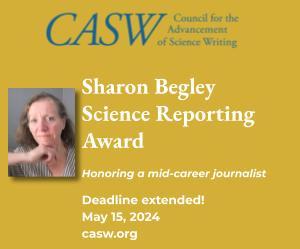This story was published as part of the 2024 Travel Fellowship Program to AAAS organized by the NASW Education Committee, providing science journalism practice and experience for undergraduate and graduate students.
Story by Krishnakoli Adhikary
Mentored and edited by Michael E. Newman
DENVER — Hesitancy — an attitude of indecisiveness because of lack of clarity — often can be beneficial, protecting us from being fooled, scammed or harmed. But when it comes to medical treatments, a group of researchers recently cautioned that it may not always be the right approach, especially when there is evidence showing a therapy is effective.
During a February 16 panel discussion at the American Association for the Advancement Science (AAAS) annual meeting, four researchers considered the behavioral patterns leading to public reluctance regarding two established preventive care measures — dental fluoridation and vaccination— and proposed ways that healthcare providers can lessen the patterns' impact.
Moderator Ichiro Nishimura, professor of dentistry and bioengineering at the University of California Los Angeles, set the tone for the discussion by expressing his concerns about dealing with the spread of misinformation and “conspiracy theories” about fluoridation and vaccination.
“If the potential receiver [of a proven treatment] won’t take it [the treatment], that’s a challenge,” Nishimura said. “The social and behavioral patterns resulting in skepticism or hesitancy toward vaccination and fluoridation are similar.”
Understanding the reasons for that resistance is the research focus for pediatric dentist Donald L. Chi, professor of oral health sciences and associate dean for research at the University of Washington School of Dentistry. “It’s essential that we know why people are hesitant in order to develop better dentist-parent communication strategies,” he said.
Chi agreed with Nishimura that hesitancy about fluoridation and vaccination follow similar patterns — across a spectrum ranging from completely accepting a treatment to totally refusing it. However, he said, a large number of patients vacillate between the two extremes, frequently leaning toward refusal.
For example, Chi explained, a 2014 study showed that five percent of patients refused fluoride for cavity prevention. However, of that small group, about 80 percent held the extreme view that topical fluoridation was totally unnecessary.
Another panelist, Jennifer Reich, a professor of sociology and the director of the university honors and leadership program at the University of Colorado Denver, pointed out that while the goal of all parents — including those who are hesitant about specific treatments — is to ultimately protect their children and make good health decisions for them, societal pressure often transcends scientific evidence when they decide if preventive care is actually beneficial.
“For hesitant parents, preventive care is viewed more as a service for personal benefit than an essential tool for community health,” she said. “Therefore, if they feel a treatment doesn’t help or could harm their child, these parents will refuse it, even if doing so may aggravate spread of disease.”
So, what can be done to combat the problem of hesitancy about preventive treatment before it negatively impacts individuals and communities? Gretchen Chapman, professor of psychology at Carnegie Mellon University, pointed out that the most effective way to address the mistrust around preventive care is to target the behavior itself.
“Trying to change beliefs, attitudes and social norms are not very effective,” she explained. “For example, studies have shown that a parent will trust a healthcare provider more when that provider also is a mother who has vaccinated their own children.”
Other means of overcoming hesitancy, Chapman said, are accessibility and regulation. During the COVID-19 pandemic, she said, having many vaccination sites available, along with mandating vaccines in organizations and schools, significantly increased vaccination uptake.
One thing about which the panelists agreed was that some hesitancies are worse than others.
“Imagine, that at the peak of the COVID-19 pandemic, you decide not to vaccinate your child, but send them to school anyway,” said Chapman. “This could lead to a propagation of the virus, thus infecting multiple individuals and causing a community breakout. However, rejecting dental fluoride treatment for your child would not be a breach of social responsibility, because it will only affect one person.”
Reflecting on findings from recent scientific studies, the panelists reported that many Americans are fascinated by natural treatments and therefore, lean toward “growing natural immunity through a healthy lifestyle.”
For example, the panelists noted, parents will refuse to get their children vaccinated according to U.S. Centers for Disease Control and Prevention recommendations because they fear doing so will “inject chemicals into their 'perfectly natural newborn’ and poison them.”
Surprisingly, the panelists reported that it’s not uncommon for parents to feed their children pears — which have 600 times the naturally occurring amount of a known toxin, formaldehyde, than most vaccines — than protect their kids against a potentially serious or life-threatening disease through vaccination.
To wrap up the discussion, Nishimura remarked that health care providers and scientists need to be open-minded in understanding the concerns of the parents.
--
Krishnakoli Adhikary is a PhD candidate in Molecular Biophysics (Chemistry) at the City University of New York. She is a volunteer science communicator and writer. She loves singing, dancing, painting, cooking and swimming. She spends her spare time traveling/hiking or cuddling cats in cat cafes. Connect with her at https://www.linkedin.com/in/krishnakoli-adhikary-336b3695.
Editor: Michael E. Newman.
Founded in 1934 with a mission to fight for the free flow of science news, NASW is an organization of ~ 2,600 professional journalists, authors, editors, producers, public information officers, students and people who write and produce material intended to inform the public about science, health, engineering, and technology. To learn more, visit www.nasw.org.

.png)

